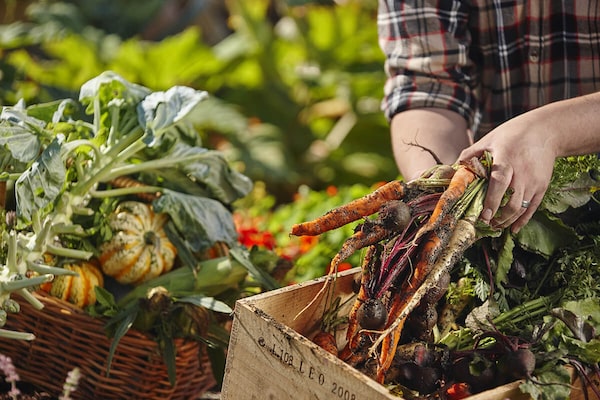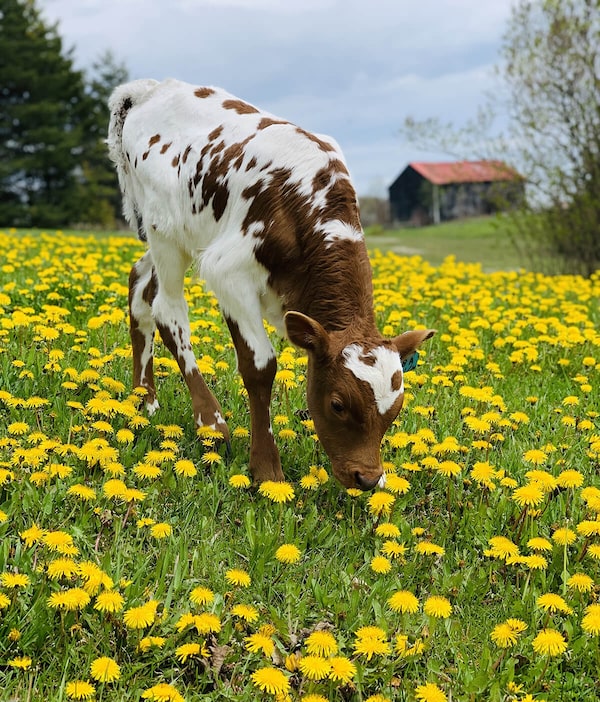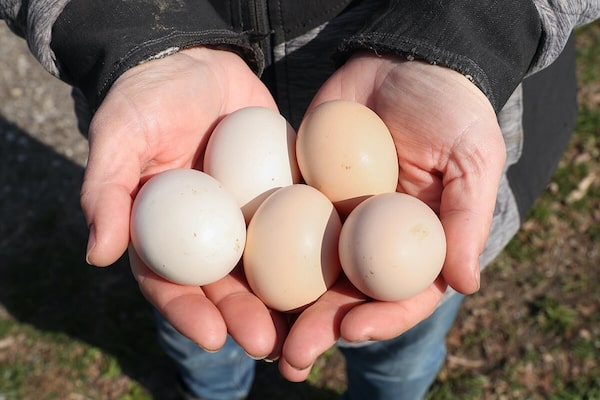
The Waring House in Prince Edward County has its own flower, vegetable and herb gardens in which they grow food served to guests without the use of pesticides.IMAGE COURTESY OF THE WARING HOUSE
The benefits of eating locally grown and produced food are almost too numerous to mention. It’s fresher, healthier, tastes better and is often safer, and because it doesn’t travel as far to reach your plate, it has a lower carbon footprint and less environmental impact. Ontario is an agricultural powerhouse that employs hundreds of thousands of workers and generates billions of dollars in GDP.
For such reasons as these, Ontarians are increasingly mindful of where their food comes from and visiting local farms and markets has become a summertime ritual for many.
Fresh, sustainable food is a cornerstone at The Waring House in Prince Edward County and, according to innkeeper Norah Rogers, it’s a big draw for guests who stay and dine at the charming country inn. Fresh and local ingredients are used in the dishes served under the watchful tutelage of its executive chef, David Correa.
The Waring House’s oldest recipe is an apple and aged cheddar soup, which uses local county cider and aged Canadian cheddar, and is topped with a glazed puffed pastry prepared with locally made Vader’s maple syrup. Prinzen’s stuffed chicken entrée is a chicken breast from a local farm served with locally grown potatoes and vegetables. The breast is stuffed with Creasy’s Apple Dabble Farm apples grown in the area and includes a reduction made from off-dry Riesling produced by Huff Estates in nearby Bloomfield.
“It means that the food you are eating was picked fresh,” Rogers says. “It means it’s not genetically engineered when we are buying things off the truck. Every vegetable is the same when you go to a farm and get vegetables yourself. People like the fact that [the food] is more ecologically sound and hasn’t been flown in from 4,000 miles away. We have markets all around us, and people also appreciate being able to support local businesses, local farmers.”

The 4th Line Cattle Co. farm is nestled among scenic, rolling hills in Hillsburgh and produces pasture-raised and grass-fed beef.4th LINE CATTLE CO. IMAGE
The Waring House also has its own flower, vegetable and herb gardens, in which they grow such staples as tomatoes, cabbages and green beans – without the use of pesticides. The Waring House is also certified under the province’s Feast On program, Rogers says, which recognizes businesses committed to serving Ontario-grown food and drink.
Sustainability is a big focus at The Waring House, whose main house is a historic limestone building built in 1860, and furnished and decorated to reflect its 19th-century origins. The lodges are heated and cooled using geothermal technology and water is heated in all of the buildings using solar power. There is a robust recycling program and all of the products used in the 49 rooms are biodegradable.
The farm-to-table or farm-to-fork movement is certainly a growing social movement about which people are increasingly passionate.
“I think it all comes down to better health benefits of nutritionally dense food and a closer connection to what you’re consuming, as well as reducing your [carbon] footprint by buying local,” says Tamaran Mousseau, a proud, first-generation farmer of the family-owned 4th Line Cattle Co.

Fresh eggs, vegetables and meat products can be found at numerous farms and markets throughout the province. Many local growers are dedicated to organic practices and sustainability.IMAGE COURTESY OF CENTRAL COUNTIES TOURISM
The farm, nestled among scenic, rolling hills in Hillsburgh, north of Halton Hills, produces pasture-raised and grass-fed beef and pork, and free-range chicken. Lush green pastures and hay fields span more than 400 acres.
“All of the cattle and pigs are born and raised here on the farm,” Mousseau says.
“We use purebred Texas Longhorn and Hereford cattle and the pigs are heritage breeds that thrive outside on the land. I think one of the factors driving interest in locally grown and produced food is just knowing where your food is coming from and the transparency in how it’s grown or raised.”
Those travelling the province truly have a bounty at their disposal: Ontario is home to more than one-quarter of the farms in Canada, according to Statistics Canada. A temperate climate, plentiful water resources and fertile soil all contribute to the production of high-quality fruits, vegetables, meats and dairy products.

Fresh eggs, vegetables and meat products can be found at numerous farms and markets throughout the province. Many local growers are dedicated to organic practices and sustainability.IMAGE COURTESY OF CENTRAL COUNTIES TOURISM
Farm visits can be a fun experience for the entire family. Central Counties Tourism offers sustainable agritourism opportunities throughout the region of York Durham Headwaters to help people better connect with the food we all eat.
After all, why go to a grocery store and buy prepackaged food that’s wrapped in cellophane and sitting on a Styrofoam tray when you can visit one of the region’s many accessible farms, learn about the animals and truly understand where your food comes from, says Susan Boyle, Central Counties Tourism’s director of marketing.
York Farm Fresh, the Durham Farm Fresh Marketing Association and Headwaters Food and Farming Alliance are all member-based organizations of farmers, producers and volunteers that have easy-to-navigate websites, online maps and directions to help travellers get a deeper appreciation of food tourism in the region. Just a few of the many worthwhile places to visit include:
- Forsythe Family Farms, a family-run farm in York Region for more than 41 years, which sells fresh fruits and vegetables via an outdoor market and pick-your-own facilities, and offers school tours and birthday parties.
- Landman Gardens and Bakery just north of Grand Valley, which is also family operated and raises pasture-raised pork, chicken, turkey and laying hens, and has a commercial kitchen off the farm where they create baked goods, ready-made meats, pickles and jams.
- Farmers markets such as the Port Perry Lakefront Farmers’ Market, Orangeville Farmers’ Market, Aurora Farmers Market and the Main Street Newmarket Farmers’ Market.
- Flower farms such as River Ridge Farm Flowers in Uxbridge, which has acres of various blooms and flower-cutting opportunities, and Avalon Lavender Farm in Mono, which is a first-generation operation with a fully restored 1881 Heritage Barn store and more than 30,000 lavender plants, a honey apiary and various farm animals.
“Shortening the journey for food to get from the farm when it was grown and raised to the table where it will be eaten means less of a chance for contamination, expiration and other issues,” says Ashley Lansink, tourism officer at the Corporation of the County of Perth.
“Shopping with local farms means shopping where food is at its most fresh. It has touched less hands, vehicles, chemicals, and more. When you support a local farmer, you get to experience farm-to-table freshness.”
Perth County’s Discover More Flavour Farm Gate Map is a good guide for the region’s agricultural offerings, through which you can customize travel experiences around vegetable exploration, meat and cheese tours, fruit and flower adventures, animal encounters, pick-your-own experiences, and syrup, jam and honey tours.
“People are looking for a sense of connection wherever they can find it and food is the perfect place for this,” Lansink says.
Advertising feature produced by Globe Content Studio. The Globe’s editorial department was not involved.